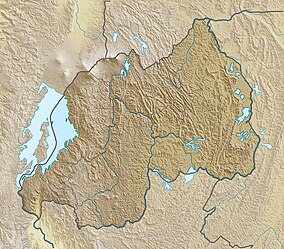Akagera National Park
| Akagera National Park | |
|---|---|
 | |
| Location | Rwanda |
| Coordinates | 01°38′S 30°47′E / 1.633°S 30.783°E |
| Area | 1,122 km2 (433 sq mi) |
| Created | 1934 |


Akagera National Park is a protected area in eastern Rwanda covering 1,122 km2 (433 sq mi) along the international border with Tanzania. It was founded in 1934 and includes savannah, montane and swamp habitats. The park is named for the Kagera River which flows along its eastern boundary feeding into Lake Ihema and several smaller lakes. The complex system of lakes and linking papyrus swamps makes up over a third of the park, which is the largest protected wetland in Eastern-Central Africa.
History
Akagera National Park was founded in 1934 by the Belgian government, which at the time occupied Rwanda.[1] The park was 2,500 km2 (970 sq mi) large and was known for its biodiversity. It used to have a large population of African wild dogs.[2] At one point, it was known as the 'Parc aux Lycaons' and wild dogs were so abundant that the Belgian government considered them a pest. However, a disease epidemic diminished the population and the last wild dogs were seen in 1984.[3] In 1957, black rhinoceros were introduced from Tanzania. In the 1970s, more than 50 black rhinos lived in the savannah-habitat of the park. Due to widespread poaching, the population declined over the following decades, and the last confirmed sighting was in 2007.[4] In 1986, Masai giraffes were introduced from Kenya. Their population has grown to 78 individuals in 2024.[5] Around 1990, Akagera was known to have a population of 250 to 300 lions.[3] In the years that followed, the entire population was killed by farmers who returned to Rwanda after the 1994 Genocide against the Tutsi and settled in the park.[6]
In 2009, the Rwanda Development Board (RDB) and the African Parks Network entered into a 20-year renewable agreement for the joint management of Akagera National Park. The Akagera Management Company was formed in 2010 as the joint management body for Akagera National Park. Over the next 5 years a $10 million expenditure was carried out in the national park area, with financial help from the Howard Buffett Foundation. The aim was to increase the security of the national park and to reintroduce locally extinct species. Security measures that were taken include: the construction of a western boundary fence which measures 120.0 km (74.6 mi), deploying an air surveillance helicopter, training of an expert rhino tracking and protection team and a canine anti-poaching unit.[4]

In July 2015, Tembe Elephant Park in KwaZulu-Natal donated two male lions.[7] This effort was described by African Parks as "a ground-breaking conservation effort for both the park and the country" as part of a project aimed at reversing the local extinction of the species in Akagera National Park. Since 2015, the lion population has grown to 58 animals.[8]
In May 2017, a joint operation by the Rwanda Development Board and African Parks saw the reintroduction of 18 Eastern black rhinoceroses from South Africa, which had been absent for 10 years. With the reintroduction of black rhinos and lions, the national park is now home to all of Africa's "big five": lion, African leopard, African bush elephant, rhinoceros, and African buffalo.[4][6]


In June 2019, Akagera National Park received five eastern black rhinoceros from three zoos in Europe after a 30-hour journey; this relocation was the first of its kind.[9][10]
In November 2021, 30 white rhinoceros were successfully translocated to Akagera National Park from Phinda Private Game Reserve in South Africa, in the largest single rhinoceros translocation aimed to extend the species' range and create a new breeding stronghold in Rwanda.[11] In 2023, African Parks reported that several new calves had been born, giving hope that the animals had adapted to the new environment.[12]
The large mammal population has increased since 2010, from 4,000 animals in 2010 to over 13,500 in 2018.[13]
Tourism
Since African Parks assumed management of the park in partnership with the Rwanda Development Board in 2010, tourism has dramatically increased. In 2010, 8,000 people visited the park. This number rose to 44,000 by 2018.[14] This increase has allowed Akagera to become 80% self-sustaining and therefore less reliant on donors.[14] The numbers for 2022 were 34,000 paying visitors and 92% of operating costs covered by park revenue.[12]
See also
- Mutara Game Reserve, an adjacent former protected area
- Serengeti
References
- ^ Hall, Sarah (2014). "Akagera Celebrates 80 Years of Conservation in 2014". African Parks. Retrieved 20 February 2024.
- ^ "1962 Contribution à la connaissance des Lycaons au Parc National de la Kagera | Archives".
- ^ a b Vande weghe, Jean Pierre: Akagera: Land of water, grass and fire / Jean Pierre Vande weghe. With collaboration of Thérèse Abandibakobwa, José Kalpers a.o. Photography by Philippe Dejace. Translated by Alicia L. Spruijt-Ray. - Brussels: World Wildlife Fund for Nature, 1990
- ^ a b c Agence France Presse (2017). "Black rhinos return to Rwanda 10 years after disappearance". The Guardian. Retrieved 3 May 2017.
- ^ "Biodiversity Conservation". African Parks. Retrieved 20 February 2024.
- ^ a b Moran, Benedict (7 May 2019). "Rwanda's war nearly destroyed this park. Now it's coming back". National Geographic. Retrieved 20 February 2024.
- ^ "Lions to bring 'East Africa experience' to Rwanda". Retrieved 2017-05-22.
- ^ "Lion population in Rwanda's national park grows to 58". Xinhua News. Retrieved 2023-05-19.
- ^ Forrester, E. M. (2019). "Successful translocation of rhinos from Europe to Rwanda". BBC Wildlife Magazine.
- ^ Gill, V. (2019). "Rhino release: Endangered animals despatched to Rwanda". BBC News.
- ^ "White Rhinos to Rwanda". www.africanparks.org. Retrieved 2023-01-05.
- ^ a b "Akagera". African Parks. Retrieved 18 February 2024.
- ^ "Big Cat Sighting".
- ^ a b "Unlocking the value of protected areas" (PDF). African Parks. 2018.
External links
- "Akagera National Park". Wildlife Conservation Society. Archived from the original on 2007-03-11.

